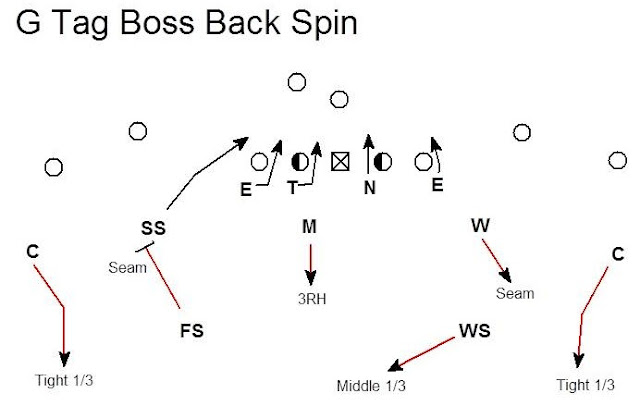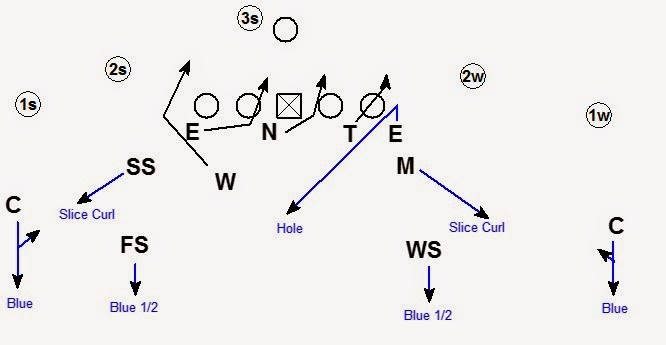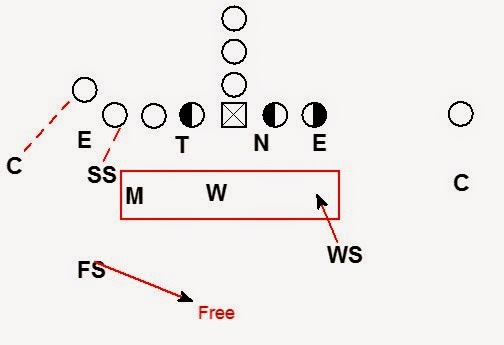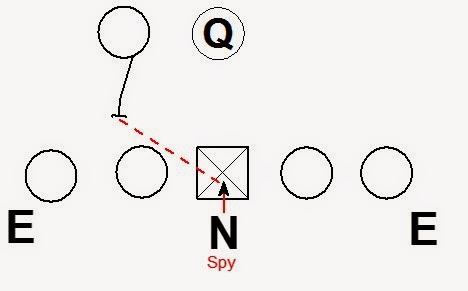I received an e-mail from a reader asking about coverage philosophy and game planning. So here goes.
Our base coverage concept is a match-up zone quarters. In every game, we plan to run multiple coverages that fall into one of three categories.
Zone – Depth, Vision, & Break coverages. In zone coverage our defenders will drop to the deepest part of a zone with vision on the QB and break on the throw.
Man – Tight aggressive one on one coverage.
Match-Up Zone – Combination of Zone & Man. Based on the pattern run by the offense, we are going to play either zone principles or man principles. Match-Up zone calls allow us to aggressively deny selected routes while playing depth, vision, and break vs. other routes.
When we are game planning coverage our priority list is:
- Run Support/Run Adjustments
- Action Passes
- Quick game/Easy throws
- DBP Route Combinations
- Specials/Trick Plays
First and foremost, every game plan starts with how to stop the run. How and where our DB’s will fit vs. the run is our first consideration when planning coverage calls. In recent seasons, we have added run adjustments to our stopping the run planning. When I say run adjustments, I’m talking about bubble, WR screen, and pop pass that are built into running plays. We always want to know how our coverage will account for those phases of the offense’s run game.
Next in our thought process is how to handle action passes. Our action pass plan will be tied to our coverage calls to defend the run. Action passes are threats of explosive plays for the offense. We want to have the best plan possible to eliminate explosives.
Third is how will we defend quick game and the easiest throws. Our goal on all quick game is eliminating yards after catch. In zone coverages, we expect our defenders to break on the throw and make sound tackles. In short yardage situations, we have to be able to play a denial coverage (man or match-up) to prevent completions. However, good vision and break from zone coverage can lead to incompletions vs. quick game too. We have been successful with defenders jarring the ball loose on quick game by making a good break and hitting the receiver before the completion of the catch.
Fourth on the list is drop back pass (DBP). We prioritize the offense’s vertical passing plays first among DBP. If the ball is completed over a DB’s head, the other ten defenders don’t get to play. If the ball is thrown underneath, all 11 defenders get to run, rally, and tackle. Every DBP coverage decision we make is evaluated based on how it matches up vertically. Our plan for DBP is built around placing mental demands on the offense. We want the QB to have to identify the coverage post-snap. By disguising and changing up the coverage, we are going to limit the offense’s ability to make a clean pre-snap read. Also by changing up the coverage, we are going to place physical demands on the offense. Take for example a 4 verticals route concept. Against a zone coverage like cover 3, the QB is going to try to throw the ball over the top of the underneath droppers but before the deep defenders. Against quarters, the offense is trying to bend a vertical into the open middle of field attempting to beat a safety 1 on 1. Against, a Cover 1 concept the QB will have to make a man beater throw into a tight window. All three situations are different for the offense. Creating mental demand (What coverage is it?) and physical demand (Making the right kind of throw) while facing a pass rush is our plan to defend DBP.
Lastly, we want to be ready for the trick plays the offense may throw at us.
In game planning, we want to force the offense to react to the coverages we are calling. By changing up the coverage call, we are being proactive. If we are spending all our time reacting to the offense’s calls in game, we have failed in the game planning phase.
How do we actually make this happen in our game plan and execution?
We start our planning with self-scout. What do we run? What tendencies will our opponent see when they break down our film? In the simplest form the offense wants to know:
- What is our base coverage?
- What are our complimentary coverages?
- When do we call them?
Being able to answer these questions for ourselves influences our game plan.
Next, we create our opponent scouting report. The coverage scouting report focuses on what route combinations they have run. How will we defend those routes in our base coverage? We want to look specifically at what has our opponent called against other quarters teams (scouting report). What have they called against us in the past (previous seasons)? What has worked against us in quarters coverage in other games this season (self-scout)? Those are the concepts we need to rep in practice all week. The down and distances when we expect to see those concepts are based on the combination of their tendencies and our self-scout. Our opponent has tendencies on when they like to call certain route concepts. They are also planning for us based on our tendencies. We can anticipate their “quarters beater” route concepts based on their scouting report (What). We can predict they will call those “quarters beaters” in situations they think we will be in quarters from our self-scout (When). Once we answer what and when, we can build a game plan.
The scouting report also influences our COP calls. C.O.P. is an acronym for change of pace.
For example:
Against quarters, offenses like to get a bender vertical or a post into the open middle of the field. If the scouting report shows that is a concept our opponent likes against quarters, we are going to plan some middle of the field closed COP calls (Cover 3 or Cover 1). In the first quarter we will make some COP calls in quarters coverage tendency situations. Proactively making those calls early, can get a team to abandon the bender/post plan. We don’t want to be reacting to them completing a post and then start making some cover 3/cover 1 calls.
Example 2:
A team on 1st down likes to throw hitch to #1 against quarters to get on schedule. We might mix in some pressed cover 1 in those situations as a COP. In those same situation we will call some press/bail technique quarters. If the offense isn’t sure the hitch will be there, often they will go away from the call. Another COP in this situation is cover 2 concept to deny the hitch. We can show the off alignment inviting the hitch only to have a corner squatting in the flat. We may only want the squat corner to the boundary so our COP might be a quarter-quarter-half concept. In other situations we want to close the middle of the field and get a squat corner. In that case our COP is a rolled cover 3 with the corner to the roll squatting in the flat. Throughout the game we will mix up quarters with COP calls.
Some offense’s like to run route combinations that are difficult for pattern match coverages. Being able to call a zone coverage in those situations can be very beneficial. The offense is expecting the defense to match-up but instead the defenders are playing depth-vision-break technique and forcing the ball to be thrown short. If you are not pattern matching, the routes designed to manipulate pattern match don’t affect your coverage. It doesn’t take many COP calls to get an offense to mark calls off the call sheet. No offensive coordinator likes wasted plays.
One question is what to do in medium and short yardage situations. We are going to start by planning to play our base quarters match-up zone. Our base alignment does not have the corners pressed. To complement our base look we will play 5 underneath zone coverage to overload the underneath zones. Typically it is a cover 2 concept with the corners aligned off the LOS.
We can also press our corners in quarters or play press man. Our aggressive coverages force precision throws. We will also show press and bail to a zone. Depending on the situation we may only press the boundary corner.
This is where the game within the game happens. If we get into short yardage we may play press man the first time. The offense is going to come back with press man beater concept the next short yardage situation. We will come back with bail to our base coverage. We may call our base coverage on short yardage. After practicing our base coverage against their short yardage routes we expect to make the play. If the offense converts, we have a good idea of what short yardage route concept the offense will come back with later in the game. We can help ourselves win the game within a game by using our tendencies and self-scout to our advantage. If our self-scout shows that our short yardage plan has been press man or bail quarters, we will plan to change up our COP calls.
Running multiple coverages is a simple concept. The issue is how do we get each coverage practiced. Our answer is limitation. When practicing we don’t call every coverage in every situation. By planning to use COP calls in specific situations we can limit the practice time for those coverages. We also try to find situations where COP calls overlap. For example the team may have 1st down tendencies that overlap with 2nd and medium situations. Being able to streamline COP calls for multiple situations can improve practice efficiency.
Overall we are game planning to mix up our zone, man, and match-up zone coverages. If the offense is locked into what coverage we are running, they have the advantage. If we have done a good job planning, we will be locked in to how the offense is going to try to attack the stress areas of our base coverage. We will spend the week being ready to defend the offense in our base coverage. If the plan is good we will have also mitigated the stresses of our base coverage by preparing COP calls. Proactive COP calls should dissuade the offense from calling routes that we want to take away. Once we have forced the offense into their 2ndor 3rd plan we will have to make in game adjustments.























































































































